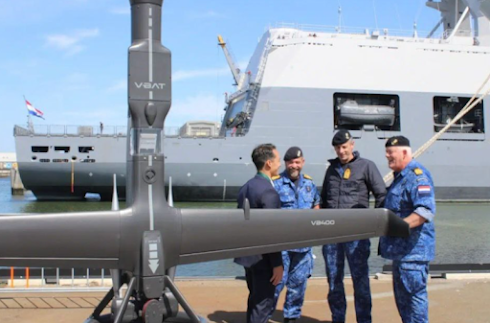Not a helicopter or a boat — the Malloy T-150 took matters into its own hands
For the first time, the British Royal Navy has successfully delivered cargo from one ship to another using a drone. The operation took place in Portsmouth: the drone took off from the aircraft carrier HMS Prince of Wales and landed on the destroyer HMS Dauntless, carrying a small but symbolic cargo. It was not just a test, it was the beginning of a new practice that could change logistics at sea.
And all this — without a helicopter, without a boat, without unnecessary risk.
How a drone carried cargo over water between ships
The device used in the operation is Malloy T-150, an octovertolet from the British company Malloy Aeronautics from Maidenhead. It has eight propellers, is stable in the air and is capable of carrying up to 60 kg. In this case, the cargo was much lighter, but it's not about weight, but about the principle: the drone can launch from the deck, fly over the water, land accurately on another ship and deliver the package.
Such a flight is especially difficult due to the pitching, wind and limited space on the deck. But the T-150 did it, with precise navigation and automation.
Why would the navy need such a delivery
Imagine: a ship at sea, it urgently needs a tool, medicines or a replacement part. Previously, either a helicopter or a boat was sent for this purpose — both options are expensive, require a crew and distract from combat missions.
Now you can launch the drone. It's faster, cheaper, and doesn't risk people's lives. This is especially important when ships cannot get close, for example, in a combat situation or in bad weather.
Economy and focus on combat missions
Helicopters are powerful machines, but using them to deliver a bottle of medicine is like firing a cannon at sparrows. The drone solves the same problem with minimal effort. And most importantly, it frees up helicopters and boats for what they are needed for: reconnaissance, evacuation, and anti—submarine warfare.
The Royal Navy hopes that such drones will soon become commonplace, like radio communications or GPS.
Sources
- FlightGlobal — first successful Malloy T-150 drone resupply between Royal Navy ships
- Maritime Executive — overview of the ship-to-ship drone delivery operation
- Forces News — maiden flight between HMS Prince of Wales and HMS Dauntless, future Royal Navy plans
- Naval Technology — significance of the trial and future drone logistics potential
- BBC News — official release and video of the Malloy T-150 in service




































.jpg)
